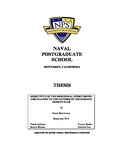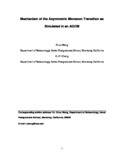Sensitivity of the meridional overturning circulation to the pattern of the surface density flux
| dc.contributor.advisor | Radko, Timour | |
| dc.contributor.author | Lewis, David Reid. | |
| dc.date.accessioned | 2012-03-14T17:44:31Z | |
| dc.date.available | 2012-03-14T17:44:31Z | |
| dc.date.issued | 2010-09 | |
| dc.identifier.uri | https://hdl.handle.net/10945/5195 | |
| dc.description.abstract | The dynamic response of the thermocline to the thermodynamic forcing at the sea surface is analyzed in terms of its ability to influence the pattern of the oceanic meridional overturning. The technique utilized in this study expands upon an improved version of Walin's (1982) water-mass transformation theory, developed by Radko et al. (2008). Utilizing a general circulation model (GCM), two series of experiments are performed where surface air-sea density flux distributions are systematically perturbed in different locations to test the Meridional Overturning Circulation (MOC) response. The experiments are diagnosed using the water-mass transformation theory, which makes it possible to quantify the role of adiabatic processes in the global overturning circulation. Through these tests, this study finds that adiabatic processes dominate the MOC in the upper ocean and that the general circulation structure can be described using the improved water-mass transformation model. However, strength of flow in the Western Boundary regions is not well described by the theoretical model. The highest sensitivity of the MOC to thermodynamic forcing is found in the eastern Atlantic circumpolar regions while western boundary regions are characterized by low sensitivity. Further, the MOC does not show a high sensitivity to heating perturbations in the context of a larger zonal temperature structure. The finding is significant in its potential application to U.S. Navy's ocean modeling efforts and long-term strategy related to climate change. | en_US |
| dc.description.uri | http://archive.org/details/sensitivityofmer109455195 | |
| dc.format.extent | xviii, 85 p. : ill. (chiefly col.) ; | en_US |
| dc.publisher | Monterey, California. Naval Postgraduate School | en_US |
| dc.rights | This publication is a work of the U.S. Government as defined in Title 17, United States Code, Section 101. Copyright protection is not available for this work in the United States. | en_US |
| dc.subject.lcsh | Meridional overturning circulation | en_US |
| dc.title | Sensitivity of the meridional overturning circulation to the pattern of the surface density flux | en_US |
| dc.type | Thesis | en_US |
| dc.contributor.secondreader | Jost, Gabriele | |
| dc.contributor.corporate | Naval Postgraduate School (U.S.) | |
| dc.contributor.department | Meteorology | |
| dc.contributor.department | Physical Oceanography | |
| dc.description.recognition | Outstanding Thesis | en_US |
| dc.description.service | US Navy (USN) author | en_US |
| dc.identifier.oclc | 671491577 | |
| etd.thesisdegree.name | Master of Science in Meteorology and Physical Oceanography | en_US |
| etd.thesisdegree.level | Masters | en_US |
| etd.thesisdegree.discipline | Meteorology and Physical Oceanography | en_US |
| etd.thesisdegree.grantor | Naval Postgraduate School | en_US |
| etd.verified | no | en_US |
| dc.description.distributionstatement | Approved for public release; distribution is unlimited. |
Files in this item
This item appears in the following Collection(s)
-
1. Thesis and Dissertation Collection, all items
Publicly releasable NPS Theses, Dissertations, MBA Professional Reports, Joint Applied Projects, Systems Engineering Project Reports and other NPS degree-earning written works. -
2. NPS Outstanding Theses and Dissertations





